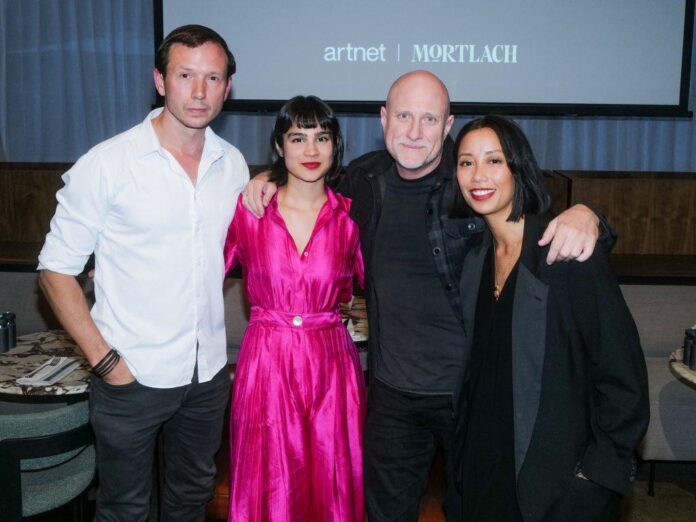A day on from the U.S. Senate‘s A.I. hearings in Washington, a very different tech-centric gathering convened in New York. This one chose three artists, rather than tech executives, as its protagonists. Together they outlined disparate futures for the art world to an audience assembled on the Spanish Steps inside NeueHouse, the hip cultural center and creative hub in the Flatiron District.
Rather than focus on A.I., the panel, hosted by Artnet and Mortlach on May 17, addressed the full complement of digital phenomena to have rocked the worlds of art and design in recent years—and why not blockchain, NFTs, and the metaverse, as well?
Whether by chance or impeccable curation, the artists at “Offscreen: The Current and Future States of Art, Design, and Technology” occupied the full spectrum of approaches to disruptive technologies, which provided contrast and moments of lively debate.

Sebastian Errazuriz, Khyati Trehan, Trevor Paglen, Sonia Manalili. Photo: Jason Crowley, courtesy of BFA.
Sebastian Errazuriz, a Chilean-born designer who is currently penning a book on A.I., advocated a whole-hearted embrace of these technologies. “We need to run towards A.I.,” he said. “Blocking it out makes no sense.” Trevor Paglen, an artist whose work has long exposed power structures through photography and investigative journalistic techniques, offered consistent pushback. The advancement of these technologies isn’t in question, Paglen said, but their terms of operation should be. In the middle (both ideologically and quite literally on the stage) was Khyati Trehan, a graphic designer and 3D visual artist who, though instinctively wary, has leveraged the latest technological developments professionally.
Despite their differing stances, all three artists are tech-forward. Each have tried their hand at the hottest new digital trends that the tech world has offered over the past three years. What differs are their approaches and conclusions.

Sonia Manalili, Trevor Paglen, Khyati Trehan, Sebastian Errazuriz. Photo: Jason Crowley, courtesy of BFA.
Errazuriz saw NFTs as an opportunity to critique notions of scarcity and value in both the digital and physical world, so set about minting blockchain-bound diamonds, a collection he believes was quickly outdated, given the speed at which the conversation changed. Rightly or wrongly, Errazuriz says, NFTs have caught a bad rap. By contrast, Paglen isn’t interested in NFTs per se, but used them for his most recent project “PRELUDES” as a way to connect with the vibrant digital community that exists, one that would play the dystopian game he’d created. “[The digital community] offers the chance of collaboration and collective problem solving, this can develop even more fruitful engagement which is satisfying for me,” he said.

The essentials for the evening. Photo: Jason Crowley, courtesy of BFA.
For Trehan, the advent of NFTs was a chance to share and sell her work with a broader community of people. But her excitement, similar to Paglen, rests with the mechanics, the potential to gamify art experiences. One such idea, which she brainstormed on stage, involves an NFT that is only unlocked after an online conversation has taken place. “The artwork would be about relationships,” Trehan says. “The process of accessing the NFT is connected to what the artwork is about.”
The artists all foresee this future in which digital art extends far beyond the current norm of on-screen JPEGs and becomes both intensely interactive and deeply personal. Paglen anticipates Netflix shows adapting their narratives viewer-by-viewer to suit tastes, and Errazuriz predicts a world in which becoming a master of tailored A.I. prompts will be an essential skill for artists. “For now most prompts are a few lines long,” Errazuriz says, “but soon these could run for pages, and the number of parameters the artist puts into the images will create something truly worth collecting.”

Artnet’s Sonia Manalili and designer and artist Khyati Trehan. Photo: Jason Crowley, courtesy of BFA.
For the technophobes present at NeueHouse, there was a nice counterpoint with the discussion of the metaverse and the future that never quite happened—at least not yet. First came Errazuriz, who discussed its recurrent false dawns. Trehan noted that she has a virtual-reality headset, but doesn’t use it much. Paglen talked about abandoning a virtual reality project because, well, headsets are just uncomfortable. There was laughter, and a momentary sense that perhaps things aren’t so certain after all.
“Offscreen: The Current and Future States of Art, Design, and Technology” will be published as a special edition of Artnet’s “The Art Angle” podcast. Check back here for the recording at a future date.

























